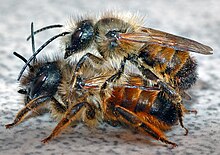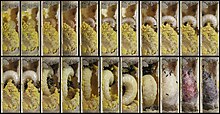| Mason bee | |
|---|---|

| |
| Osmia bicornis | |
| Scientific classification | |
| Domain: | Eukaryota |
| Kingdom: | Animalia |
| Phylum: | Arthropoda |
| Class: | Insecta |
| Order: | Hymenoptera |
| Family: | Megachilidae |
| Subfamily: | Megachilinae |
| Tribe: | Osmiini |
| Genus: | Osmia Panzer, 1806 |
| Type species | |
| Apis bicornis Linnaeus, 1758
| |
| Species | |
|
>300 species, including | |



Mason bee is a name now commonly used for species of bees in the genus Osmia, of the family Megachilidae. Mason bees are named for their habit of using mud or other "masonry" products in constructing their nests, which are made in naturally occurring gaps such as between cracks in stones or other small dark cavities. When available, some species preferentially use hollow stems or holes in wood made by wood-boring insects.[1]
Species of the genus include the orchard mason bee O. lignaria, the blueberry bee O. ribifloris, the hornfaced bee O. cornifrons, and the red mason bee O. bicornis. The former two are native to the Americas, the third to eastern Asia, and the latter to the European continent, although O. lignaria and O. cornifrons have been moved from their native ranges for commercial purposes. Over 300 species are found across the Northern Hemisphere. Most occur in temperate habitats within the Palearctic and Nearctic realms, and are active from spring through late summer.[2]
Osmia species are frequently metallic green or blue, although many are blackish and at least one rust-red. Most have black ventral scopae which are difficult to notice unless laden with pollen.[1] They have arolia between their claws, unlike Megachile or Anthidium species.[1]
Historically, the term mason bee has also been used to refer to bees from a number of other genera under Megachilidae such as Chalicodoma, most notably in "The Mason-Bees" by Jean-Henri Fabre and his translator Alexander Teixeira de Mattos in 1914.[3]
- ^ a b c Michener, Charles D. (2007). The Bees of the World (2nd ed.). Johns Hopkins University Press. ISBN 978-0801885730.
- ^ Sedivy, C.D.; et al. (2013). "Host range evolution in a selected group of osmiine bees (Hymenoptera: Megachilidae): the Boraginaceae-Fabaceae paradox". Biological Journal of the Linnean Society. 108: 35–54. doi:10.1111/j.1095-8312.2012.02013.x.
- ^ Fabre, Jean-Henri (1914). The Mason-Bees. New York: Dodd, Mead and Company.